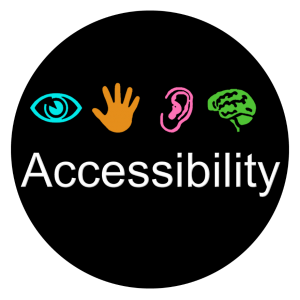 Accessible content doesn’t just benefit those with disabilities. For example, in the case of web video, captioned content benefits ESL students and those who prefer to learn by both reading and hearing new terminology. In a sound-sensitive environment like a library, captioned video can be watched without disturbing those nearby. Essentially, content is most useful when it’s available and digestible in whichever format a user needs, including audio, video, or text.
Accessible content doesn’t just benefit those with disabilities. For example, in the case of web video, captioned content benefits ESL students and those who prefer to learn by both reading and hearing new terminology. In a sound-sensitive environment like a library, captioned video can be watched without disturbing those nearby. Essentially, content is most useful when it’s available and digestible in whichever format a user needs, including audio, video, or text.
The term “universal design” refers to the idea of creating products and environments whose features are as usable as possible to the widest variety of people as possible, regardless of their age, ability, or status. Below are the 7 principles of universal design to keep in mind when evaluating current online course offerings.
- Equitable Use: design provides the same means of use for anyone accessing resources: identical whenever possible, equivalent when not.
- Flexibility in Use: design accommodates a wide range of individual preferences and abilities. (e.g., left or right handed access and use.)
- Simple & Intuitive Use: design is easy to understand, regardless of the user’s experience, knowledge, language skills, or current concentration level.
- Perceptible Information: design communicates necessary information effectively to the user, regardless of ambient conditions or the user’s sensory abilities.
- Tolerance for Error: design minimizes hazards and the adverse consequences of accidental or unintended actions.
Low Physical Effort: design can be used efficiently and comfortably. (e.g., online classes allow consumption of information with little eye strain and fatigue.) - Size & Space for Approach & Use: design provides for approach, reach, manipulation, and use regardless of user’s body size, posture, or mobility. (e.g., online learning platforms allow for the use/integration of assistive devices such as a JAWS reader.)
This information was taken from 3PlayMedia’s 2015 Roadmap to Web Accessibility in Higher Education.

